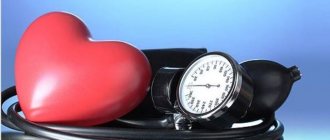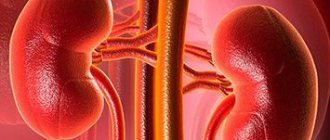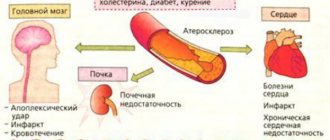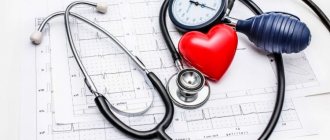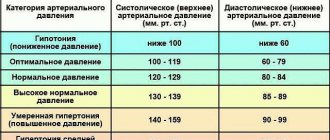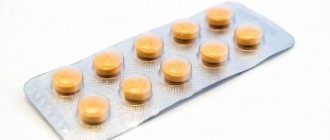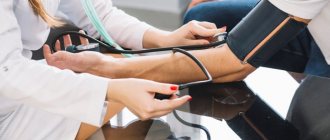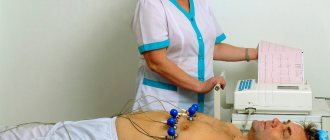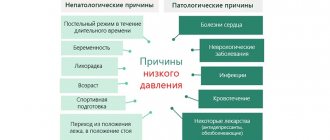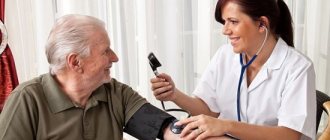Despite the accepted standards, each person has his own comfortable pressure numbers at which he feels normal. But for many, the 100/60 tonometer readings begin to frighten even if they feel well. Should you be afraid of hypotension and how can you tell if a pressure of 100 over 60 is normal?
In some cases, a pressure of 100 over 60 is normal
Normal blood pressure parameters
Blood pressure (BP) indicates the strength of myocardial contraction and arterial tone. Indicators change with diseases of the kidneys, thyroid gland, and also during pregnancy. The pressure rate is determined by three parameters:
- Upper or systolic blood pressure indicates the strength of contraction of the myocardium - the heart muscle.
- The lower value is diastolic blood pressure, indicating the degree of tension of the vascular walls in the period between heartbeats.
- The difference between the top and bottom numbers is called pulse pressure.
Myocardial contractility affects the level of systolic blood pressure. The lower figure directly depends on the tone of the artery walls, as well as on the volume of circulating blood.
Important! Pulse pressure normally varies from 35 to 50 mm. For young and healthy people, the ideal difference is 40 mm. Deviations of the indicator towards a decrease or increase indicate a pathology that requires treatment.
In medicine, normal pressure is considered to be 120 to 80 mm. RT. Art. Cardiologists use the term working pressure at which a person feels comfortable. But numbers above 140 over 90 mean arterial hypertension, and below 90 over 60 – hypotension.
Which doctor should I contact?
If you have a problem with blood pressure fluctuations, you should contact a cardiologist. The doctor will conduct a medical examination and prescribe conservative treatment according to an individual plan, taking into account an analysis of the actual indicators of the body as a whole.
Read also: Why do my ribs hurt?
To clarify the reasons, visit a therapist and neurologist. A comprehensive study and diagnosis will allow you to quickly determine the correct cause of the pathology and prescribe effective treatment in accordance with the needs of the body.
For whom 100 by 60 mm RT. Art. – norm
For most young people, mainly women, a constant pressure of 100 over 60 is normal. This indicator occurs:
- with normal or low weight,
- for non-smokers,
- athletes,
- physically active,
- with constitutional features.
Important! If 100 to 60 remains constant, and there are no complaints and you feel good, there is no need to take therapeutic measures. This blood pressure value does not pose any danger.
General recommendations
Additional means that increase blood pressure are maintaining a healthy lifestyle - you should not smoke or drink alcohol.
Sleep at least 8-9 hours a day. Good sleep contributes to proper rest of the whole body. It will also be useful to take a short rest for half an hour once a day to restore moral and physical strength.
To avoid problems with blood pressure, it is important to follow a sleep schedule.
To normalize blood pressure, it is worth reviewing your diet. Balance your menu with fortified foods.
Morning walks in the fresh air tone the body well. Avoid heavy physical overload and emotional stress.
To control blood pressure, measure your blood pressure with a tonometer at least once a day.
Short-term blood pressure lowering and first aid
In healthy individuals with normal blood pressure, the readings may drop to 100 to 60. The following factors contribute to this:
- abruptly getting out of bed - orthostatic hypotension,
- overheating in hot weather or on the beach,
- dehydration,
- standing on your feet for a long time,
- staying in a stuffy room.
Therapeutic measures are provided when symptoms appear - darkening of the eyes, dizziness, pallor of the skin, severe weakness.
First aid:
- Place the patient on his back without a pillow.
- Raise your legs above your torso.
- Give 20-30 drops of eleutherococcus extract, tincture of Schisandra chinensis or ginseng to drink.
Phytostimulants of plant origin increase blood pressure and improve cerebral circulation. If you don't have medicines at hand, call an ambulance. While waiting for doctors, give fluids to drink.
In case of hypotension due to dehydration, the volume of circulating blood is replenished by taking water, sweet tea, or compote. If your blood pressure drops after getting out of bed, coffee in the morning helps. For 2–3 weeks, it is recommended to take tonic herbal herbal preparations: eleutherococcus, lemongrass or ginseng in the first half of the day. The course of treatment is 2–4 weeks, 20 drops twice a day.
First aid for hypotensive crisis
To quickly raise your blood pressure, take a Citramon or Pantocrine tablet. The medicine stimulates cardiac activity, thereby providing vascular tone. It is impossible to take medications constantly, therefore, to normalize the condition, it is necessary to undergo a medical examination.
Citramon increases blood pressure
If you don't have medication on hand, drink a cup of hot tea or coffee and lie down with your feet slightly higher than your head. Free your chest from tight clothing - this will ensure free access of air.
Before the doctor arrives, you should not get up or engage in any physical activity.
Reducing blood pressure to 100 to 60 in older people
If such pressure appears at an advanced age or in persons suffering from hypertension, signs of circulatory failure develop:
- darkening in the eyes,
- nausea,
- dizziness,
- blurred vision,
- pale skin,
- severe weakness
- drowsiness,
- shallow breathing,
- cold sweat,
- depression,
- fainting is possible.
See also: List of high blood pressure medications for older people
If the decrease in blood pressure is not associated with taking antihypertensive drugs, older people should consult a doctor. The reasons can be very different - cerebrovascular accident, the initial stage of myocardial infarction.
Diagnostics
Diagnosis of diseases of this type is carried out by cardiology specialists. If necessary, third-party doctors are involved, such as an endocrinologist or neurologist.
A systematic examination consists of eight procedures:
- Assessment of patient complaints. Allows you to get an idea of the symptoms of the pathological process. It is possible to use questionnaires.
- Medical history examination. All somatic diseases, lifestyle, and physical activity characteristics are taken into account. Diet, drinking regime, etc.
- Measuring pressure using a tonometer. It is carried out without fail on different hands with a difference of 10-15 minutes.
- Daily measurement of blood pressure using a special Holter monitor.
- Electrocardiography. Necessary for assessing the condition of the heart and its functional activity.
- Encephalography to determine the nature of the brain and cerebral structures.
- Blood tests for thyroid and pituitary hormones.
- General blood test (or CBC).
This is enough in the system. A neurological assessment is also carried out, if necessary. Patient's mental status. After diagnosis, you can begin treatment.
A sharp decrease in blood pressure from 100 to 60 - first aid
A person's blood pressure is 100 over 60 and is dangerous if it has dropped quickly from normal levels. This happens in the following cases:
- blood loss after injury,
- a consequence of prolonged lying position of the patient,
- severe infections
- diarrhea,
- taking diuretics and antihypertensive drugs,
- internal bleeding from the stomach or intestines,
- physical exhaustion,
- lowering blood glucose in diabetics,
- allergic conditions,
- paroxysmal tachycardia,
- atrial fibrillation,
- myocardial infarction,
- taking drugs.
In such cases, emergency assistance is required. A sharp decrease in blood pressure is dangerous due to disruption of the blood supply to vital organs - the brain, heart.
What to do if your blood pressure drops quickly:
- without wasting time, call an ambulance,
- put the person on his back with his head down, while raising his legs,
- In the hospital, during infections, doctors restore the volume of circulating blood with intravenous drips of saline. At the same time, antibiotics are used
- in case of blood loss after injury, plasma and rehydrants are administered.
Important! Do not try to diagnose on the Internet and treat using traditional methods. Losing time can cost a person his life.
How to increase blood pressure with medications
The most effective and powerful medications that can quickly normalize blood pressure levels are:
- Fludrocortisone. Prescribed for dizziness and faintness.
- Niketamide. Available in the form of drops and injections. Able to quickly normalize blood pressure levels at home.
- Heptamil. A non-toxic and effective drug that has a beneficial effect on the functioning of the heart and blood vessels. Take with a sharp decrease in blood pressure against the background of a pre-fainting state.
- Epinephrine. The effect of increasing blood pressure is achieved through the effect of the drug on vasoconstriction.
Fludrocortisone will help normalize blood pressure
In case of single fluctuations in blood pressure levels, it is recommended to use lighter and less dangerous herbal-based drugs.
- Ginseng tincture. It has a tonic effect, strengthens vascular walls and increases the body's resistance. Quickly neutralizes the phenomenon of low blood pressure.
- Eleutherococcus extract. It is characterized by a mild effect on cardiovascular activity and provides an increase in blood pressure by normalizing blood circulation.
- Pantocrine. Acts on the central nervous system, stimulates blood flow in the vessels of the brain.
- Schisandra tincture. It has a general strengthening and tonic effect.
How to raise blood pressure using folk remedies
Homemade folk remedies that quickly increase blood pressure include coffee, tea with lemon, nut kernels or dark chocolate.
Tea can help raise blood pressure at home
Auxiliary folk recipes for increasing blood pressure
- Rosehip tea, drink half a glass every day. 2 tbsp. l. pour 250 ml of boiling water over the berries and let it brew for 10-15 minutes.
- A decoction of red rowan leaves. Let it brew for about an hour and add 1 teaspoon to the tea. This strengthens the vascular walls.
- A herbal infusion of nettle, chicory (root), plantain and dandelion leaves has an excellent tonic effect. Pour boiling water over the ingredients. The infused decoction is taken 50 ml 3 times a day before meals.
Read also: How to choose an intrauterine device
A decoction of rowan leaves is an effective remedy for increasing blood pressure.
What to do if you have low blood pressure and a high heart rate
First of all, let's define it - the normal heart rate (HR) in adults varies from 60 to 90 beats per minute. The parameters depend on body position, time of day and physical activity. If the pressure is 100 over 60 and the pulse is 60, no measures need to be taken - these are normal parameters.
Completely different reasons can cause a blood pressure of 100 over 60 against the background of a pulse above 90 per minute. In most cases, tachycardia is observed with the following pathology:
- heart disease,
- state of shock
- taking certain medications,
- blood loss or dehydration
- vegetative-vascular dystonia.
Treatment begins with a diagnosis. To do this, you need to see a doctor who will do an examination of the patient - an ECG, a blood sugar test. Important! Until the cause of tachycardia is determined, you should not take any medications for the “heart” - they can further lower your blood pressure and speed up your pulse.
If the person's condition is poor, call an ambulance. Therapeutic tactics depend on the cause that caused hypotension with tachycardia:
- in case of shock, resuscitation measures are carried out,
- in case of bleeding, cardiotonic drugs are indicated,
- in case of a heart attack or dangerous arrhythmias of the patient, a complex of resuscitation measures is carried out.
For tachycardia in some patients, it is enough to adjust the dosage of regular medications. Rapid heartbeat caused by stress is relieved with sedatives.
Reasons for the maximum permissible blood pressure norm
Pressure 100/60 may be secondary in nature when its drop is due to internal pathology.
With normal heart rate
Typically, a normal pulse corresponds to physiological hypotension, which is characteristic of:
- asthenics;
- inhabitants of the highlands, polar regions, tropics;
- athletes.
There is no discomfort felt.
If the pulse is 90-100 beats/minute
Tachycardia due to hypotension is the result of a decrease in circulating blood volume, which occurs when:
- dehydration of various origins;
- bleeding of various etiologies with large blood loss;
- burns;
- liver and kidney diseases;
- anaphylactic shock;
- hypoglycemia;
- panic attack.
A rapid pulse is a compensation for normal oxygen supply to vital organs or a reaction to myocardial conduction disturbances.
With bradycardia, pulse below 50 beats/minute
Low pulse with prehypotension is a common phenomenon and occurs:
- if a person is hypothermic;
- in any trimester of pregnancy;
- in athletes;
- in the elderly;
- with pathology of the cardiovascular system (cardiosclerosis, ischemic disease, weakness of the sinus node);
- poisoning;
- infections;
- hypothyroidism;
- anemia.
Another cause of bradycardia may be a hereditary predisposition or allergy.
Vegetovascular istonia
Often there is a blood pressure of 100 over 60 in combination with a pulse of 110 per minute with vegetative-vascular dystonia. With this disease, a person must be able to help himself. First of all, you need to relax and lie down with your legs elevated. A tincture of motherwort or valerian, or tea with mint will help you calm down. You cannot drink coffee or alcohol in this state.
Giving up bad habits will help prevent palpitations and low blood pressure during vegetative-vascular dystonia. Smoking and alcohol negatively affect the heart and nervous system. To get rid of the disease, it is recommended to reconsider your lifestyle - the body needs a full night's sleep and a balanced diet.
The complex of therapeutic measures includes various types of therapy:
- To stimulate vascular tone, it is recommended to take a contrast shower daily.
- Exercise, brisk walking, and swimming strengthen the heart and nervous system.
- Drug treatment consists of drugs of various groups - sedatives, cardiometabolic, vasodilators and vitamin complexes.
- Phytostimulants of plant origin are taken in courses of 2–3 weeks. Eleutherococcus, ginseng or Chinese schisandra drink 20-30 drops 2 times a day.
- It is important to learn to control your emotions. If you are nervous, massage the anti-stress point located at the bottom of the chin.
Also, pay attention to the daily menu. A proper diet consists of meat, fish products, vegetables and fruits. Depleting diets sooner or later lead to disruption of the structure of the vascular wall, heart muscle and all other organs.
What to do
Physiological prehypotension does not require any special treatment. The criterion is the general condition of a person, his comfortable state of health. Pathological – requires identifying the root cause and eliminating it. Tonometer readings of 100/60 in this case may be the first and only harbinger of tuberculosis, stomach ulcers, and viral hepatitis. Therefore, when:
- vomiting;
- convulsions;
- arrhythmias;
- confused consciousness;
- shortness of breath;
- chest discomfort - calling an ambulance is required.
Otherwise, prehypotension behaves very calmly and does not require emergency measures.
At home
What to do if blood pressure has crossed the maximum permissible line of 100 to 60, but there has been no sharp deterioration in health? At home, you can use the following algorithm of actions:
- drink a cup of natural (insoluble) coffee, strong tea;
- take tincture of Eleutherococcus, Schisandra, Leuzea and other natural adaptogens;
- in order to prevent orthostatic disorders, do not get up from a chair abruptly;
- ventilate the room you are in;
- do physical exercises to increase the tone of blood vessels and muscles (stand on your toes several times, clench and unclench your palms), in the future - swimming, yoga, race walking;
- ensure normal sleep;
- balance the diet: lots of fruits and vegetables, seasonings, herbs, salt - up to 10 g/day;
- at least 2.5 liters of water daily;
- exclude alcohol, nicotine, drugs.
Blood pressure is your lifestyle, and only you can make it your ally.
Medicines
If home remedies do not help raise blood pressure to the maximum permissible norm, use the following drugs:
| Name | Properties |
| Citramon from the caffeine-containing group | Relieves headaches |
| Cerebrolysin, Nootropin (read: what are nootropics) | Increases vascular tone, especially the brain, improves the emotional sphere |
| Tanakan – thrombolytic of plant origin | Improves blood viscosity, normalizes blood circulation |
| Saparal – neurotonic | Prevents overwork, relieves depression, asthenia, not taken at night |
All drugs have many contraindications and side effects, so they are not used without a doctor’s prescription.
Signs of hypotension
Symptoms of hypotension are manifested not only by the characteristic throbbing headache in the temples and back of the head, nausea and vomiting, pale skin and profuse sweating. During attacks, you may feel dizzy or even faint.
The patient becomes weather-dependent, lethargic, weak and constantly tired. He constantly lacks air even with minor physical exertion. At the same time, performance, attention, and concentration decrease. Your health worsens, your limbs get cold in the heat, you constantly want to sleep.
The main reasons for pressure 100/60
Low blood pressure may be completely natural and not cause any discomfort. This phenomenon is typical for young people, athletes accustomed to extreme stress, and residents of high mountain areas. It is especially common in women under 40 years of age. But due to insufficient blood supply to internal organs and the brain, the following symptoms may develop:
- impaired concentration, memory impairment;
- fast fatiguability;
- dizziness;
- often headache, throbbing pain, localized in the temporal or occipital zone;
- nausea, possible vomiting;
- violation of thermoregulation, numbness of the lower and upper extremities, chills.
Hypotension is a consequence of very diverse reasons:
- poor nutrition;
- low physical activity;
- pregnancy;
- diseases of the nervous or endocrine system;
- allergic reactions;
- dehydration;
- blood loss;
- taking certain medications (diuretics, antidepressants, antihypertensive drugs).
